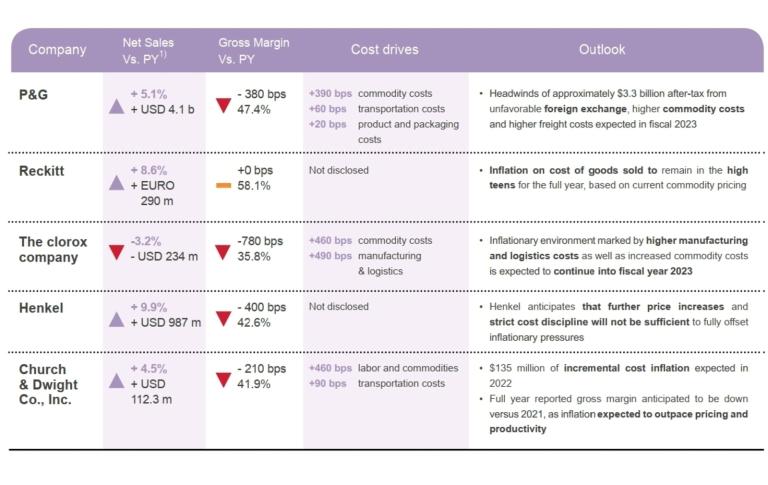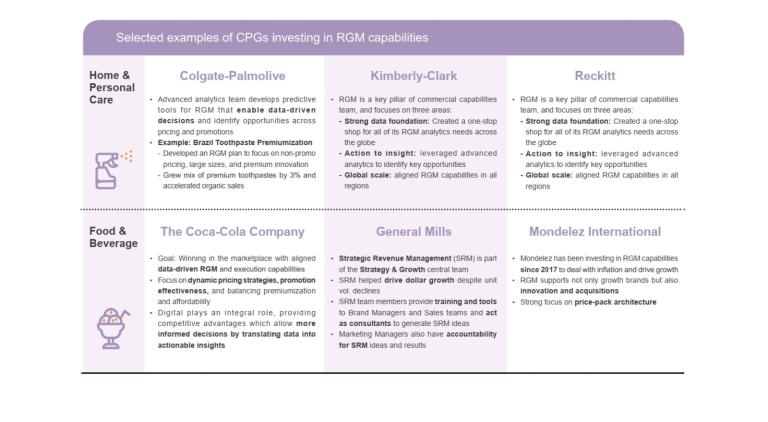

FMCG Revenue Growth Management in inflationary market
By Hugo Texier
"We expect winners to re-focus RGMs initiatives to capture value from shoppers by balancing their strategies across 5 levers i.e., Price, Trade, Pack, Promotion & Assortment."
The FMCG industry in Asia Pacifc & China saw only a modest 2% growth in 2022 (compared to global FMCG growth of 6%). Some FMCG categories are poised for growth (e.g. food, health & wellness), while some are expected to remain stagnant (e.g. personal care, household essentials) and some to decline (e.g. alcoholic beverages). Thus, FMCGs need to be well-equipped to face the oncoming challenges.
In this article, we present our views on what winners will do, i.e. refocus their Revenue Growth Management (RGM) strategies to create an extra proftability lever beyond cost-cutting and blanket price increases in light of infationary markets.
Ever-changing consumer behaviors.
Customers are less loyal: 25% to 40% of customers have experimented with different brands during the pandemic, opening opportunities for players which are not typically leaders in their segments. Consumer packaged goods (CPG) companies responded, but post-COVID, new behaviours took place, and old behaviours evolved. This also gave rise to increased pressure of private label: with rising infation and fear of an upcoming recession, consumers are increasingly looking for value alternatives.
Sharp differences in recovery rates between households causes greater differentiation of customer’s personas and raises strategic questions about product placement, price point, channels and what to promote.
Costs increase and supply chain disruptions.
CPGs face a multitude of challenges, including a “perfect storm” of cost increases. These cost pressures are evident in all aspects of their operations, from raw materials and packaging to labor, manufacturing, and logistics. As a result, CPGs are forced to carefully balance pricing in order to maintain market share while also remaining proftable.
In addition to cost pressures, CPGs are also facing increased risks related to supply shortages. The Russia-Ukraine confict and Chinese government economic intervention have combined to create a surge of out-of-stock situations, which can damage the relationship between CPGs and their customers. This issue is compounded by market volatility, which makes volume forecasting diffcult and severely impacts inventory positions.

The accelertion of e-commerce trade.
In 2025, the ecommerce market in Southeast Asia is projected to reach a volume of USD 210 billion, making it a crucial battleground for consumer packaged goods (CPGs) companies. One noteworthy trend is that ecommerce has emerged as the fastest-growing grocery format, with a compound annual growth rate of approximately 23% compared to low single digits for brick-and-mortar grocery stores from 2018 to 2022.
The pandemic has accelerated the shift towards digital purchases, forcing companies to adapt their customer outreach methods, which has both created opportunities and posed threats to their business models.
As ecommerce continues to gain momentum, FMCGs must develop tailored online strategies that encompass product, price, and promotion in order to compete with new market entrants.
Given the current situation, it is anticipated that FMCGs will shift their focus towards Revenue Growth Management (RGM) initiatives aimed at extracting value from shoppers. To accomplish this, they will need to balance their strategies across five key levers: Price, Trade, Pack, Promotion, and Assortment.
Trade: improve FMCGs cooperation with retailers & distributors.
FMCG companies will employ performance indexes based on ROI for their distribution partners to fine-tune their sales strategies. Additionally, they will make investments in digital capabilities to increase internal productivity, mitigate the impact of rising commodity prices, and maintain their competitiveness. Successful companies will also establish strategic partnerships with their primary customers to develop mutually beneficial, value-creating trading terms that will endure over the long term.
Price: differenciate to maximize profitability.
Successful companies will utilize everyday pricing strategies to improve their brand perception, while taking into account price elasticities across various markets and channels. They will employ granular data analytics to analyze historical performance under specific market conditions, and make reactive price adjustments as necessary. To safeguard their brand value perception, they will gradually increase prices on discretionary goods, while keeping prices stable for essential items. In cases where price increases are unavoidable, they will proactively inform consumers to prevent complaints and potential brand switching.
Promotion: optimize across profit, brand awareness and volume gains.
Major CPG companies are focused on achieving promotional optimization by adjusting promotion floors/ceilings and frequencies to maximize their ROI. They will adopt a more comprehensive approach to evaluating the effectiveness of promotions, taking into account both short-term and long-term impacts to prevent potential cannibalization of non-promotional sales. In light of the challenges presented by rising costs and declining disposable incomes, there will be a heightened emphasis on promoting essential goods to retain customers.
Pack architecture: adapt to capture different shopping missions.
Successful businesses strive to provide consumers with the appropriate sizes, quantities, and prices that align with their shopping goals, purchasing channels, and customer categories. For instance, Indonesian customers tend to prefer smaller-sized packaging for items such as cosmetics or household products at a more affordable price point. Additionally, companies must customize and enhance their product offerings for each sales channel, such as convenience stores, mass retailers, and general trade outlets, to increase sales and differentiate themselves from competitors.
Assortment & Mix: evolve the portfolio of product across channels.
Successful companies will adapt their product portfolios and optimize their assortment and channel distribution to increase sales and profits. They will achieve this by providing the appropriate range of products based on genuine incremental sales potential, enabling them to gain market share while minimizing the cost of complexity. Additionally, they will conduct thorough evaluations of their product range and initiate rationalization programs to reduce the number of SKUs that do not significantly contribute to top-line growth. Companies will also need to adapt their portfolios to meet the growing demand for premium products in fragmented and complex Southeast Asian markets, such as modern trade versus general trade, Singapore versus Indonesia, and so on, while expanding product categories to meet the diverse needs of consumers.
In this article, we assert that in order to effectively combat the effects of inflation, changing customer habits, and the digitization of trade, successful FMCGs must refocus their RGM strategies. The key to achieving profitable growth lies in the optimization of all RGM levers, including Price, Promotion, Pack architecture, Trade, and Assortment.
To implement these new strategies, CPGs must invest in people, process, and technologies to enhance their insights capabilities. The winning companies will prioritize investments in trade promotion and price optimization tools, data science, and consumer intelligence, enabling them to better understand price elasticities, improve cost visibility, and enhance their consumer and customer insights. Furthermore, they will diversify their product portfolio through organic or inorganic product innovation, and expand their channel and category strategies in order to capture new segments and territories. These efforts may lead to increased M&A activities in the region.

Register now to download the full Special Edition of the Private Equity Asean Newsletter. Additionally, you will receive this quarterly newsletter on a regular basis.

